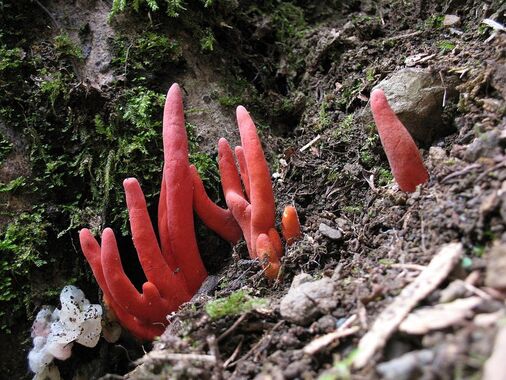|
Author: Russell Gray Over the past week, there has been a recent viral wave of posts by several news outlets, and science communication sites, including the likes of the Guardian, BBC, and IFLScience. The topic of these viral articles being the discovery of a deadly fungi species native to Japan, tentatively called the "fire coral fungi" (Podostroma cornu-damae) in Australia. Unfortunately, there is an important bit of misinformation within all of these articles which should be addressed.
First off, lets go over the the claims each article makes...
Well, I reached out to Dr. Barrett confused of how this could be possible and here is what he said: "Hi Russell, The records of dermatitis appear on contact appear anecdotal, and most people do not seem to have symptoms on handling it - it is possible the reports are actually post-ingestion skin-delimination that were assumed to be contact injuries. Nevertheless, the class of compounds, trichothecenes, ARE well-known to be able to pass through skin, and have even been turned into chemical weapons for their ability to be absorbed on contact - see the attached papers (1, 2, 3, 4). So my comments were merely intended to warn people of it in case, given their extreme toxicity and likely variable reactions. My original release actually downplayed the skin contact angle, my intention was merely to warn people to be careful of it, mainly because of a budding 'natural medicines' culture up here in Cairns collecting 'Australian Reishi' that could inadvertantly collect this instead, as has happened in Japan. But of course the media hooked onto the least important and most sensational aspect - I probably should have forseen that and not mentioned it at all, hindsight is always 100%... I hope that answers your question. Matt" In Conclusion To set the record straight, some trichothecenes are capable of passing through membranes, and have even been weaponized because of their ability to do this. However, the trichothecenes in the Soviet bio-weapon "yellow rain" were not the same toxins as are found in Podostroma cornu-damae and it is important to note that these were concentrated mycotoxins that were weaponized, not the fungi themselves. There are currently no scientific or medical reports to this day verifying that Podostroma cornu-damae is toxic when touched. Although this may seem like a harmless error, mycophobia is prominent throughout the world, and bits of misinformation like this tend to snowball out of control with social media. In the future, when you see a sensationalist headline like the ones being written for this fungi, remain skeptical, and do a quick fact-check before sharing.
2 Comments
Pedant
1/14/2024 03:46:23 am
Yellow rain would be a chemical weapon, not a bioweapon. It also was not an actual weapon of the Soviets, rather being Cold War era US propaganda. Only material ever posited to be this yellow rain turned out to be pollen grains defecated by bees and not some trichothecenes.
Reply
Russell
1/14/2024 05:09:43 pm
Thanks for the clarifications!
Reply
Leave a Reply. |
AuthorRussell J. Gray Archives
April 2021
Categories |


 RSS Feed
RSS Feed
